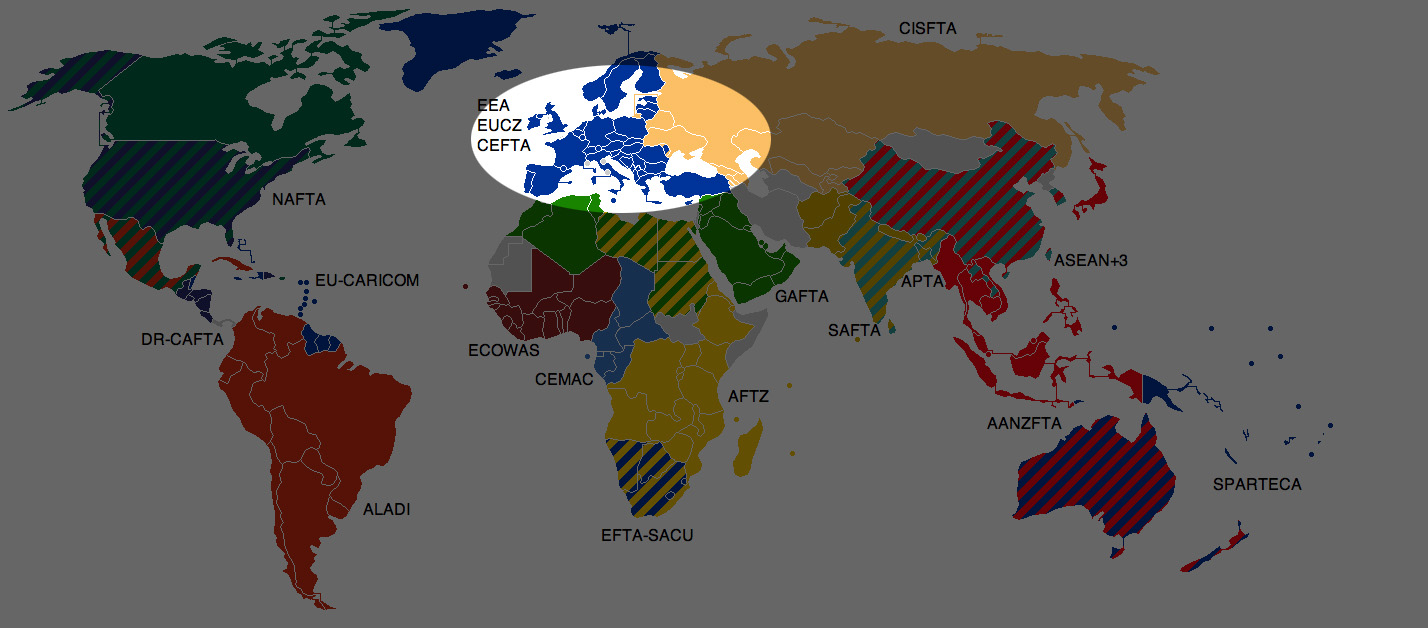To look at a series of maps highlighting of the history of the Central European Free Trade Agreement, one will be amazed to see how the landscape has drastically changed in the last decade. Founding members of the FTA have long since left the union, while lesser Balkan states comprise the bulk of the trade zone. Economical changes in Europe have had a great effect on CEFTA and how it operates, which may led some to speculate if this agreement will remain valid in the near future, or else become absorbed into the European Union.

CEFTA has its roots in an agreement finalized in 1992 that created a free trade area between Poland, Hungary, and what was then known as Czechoslovakia, which split into the Czech Republic and Slovokia by the time CEFTA went into effect two years later. The original intent of CEFTA served to assist these countries in not only taking advantage of tariff-free trade with each other, but to become better integrated with markets in Western Europe and eventually operate with them as equals. One can say that CEFTA served as a base to prepare these economies for inclusion in the European Union.
While CEFTA admitted new member nations over the years - namely Slovenia, Romania, Bulgaria, Croatia, and Macedonia - others took their leave over time to join the European Union. In 2004, the founding nations left the treaty for the EU, and others have since followed suit. Presently, CEFTA is comprised of the following:
- Albania - Albania is a prime exporter of textiles and footwear in Eastern Europe. More than half their output is traded to Italy, which is also their main import partner.
- Bosnia and Herzegovina - Aluminum, wool, and steel comprise the bulk of this area's export trade. CEFTA member Croatia counts among the area's more frequent trade partners.
- Croatia - While Croatia is perhaps the most advanced nation to come out of Yugoslavia, a good amount of their export product is agrarian - lumber, grains, and other foods.
- Kosovo - Kosovo is primarily a mining economy, and as such exports metals to trade partners, of whom Macedonia is the most frequent.
- Macedonia - Once the poorest province of Yugoslavia, Macedonia has enjoyed a steady increase in GDP in recent years. The nation relies upon machinery and industrial imports from European trade partners and exports a variety of foodstuff to CEFTA neighbors.
- Moldova -While one of the poorer nations in CEFTA, Moldova maintains their GDP with help from their active wine production. As one of the top thirty wine producers in the world, Moldova exports the bulk of their output throughout Europe.
- Montenegro - Agricultural output - foodstuffs and raw materials - make up the bulk of this nation's export product. Switzerland is a prime trade partner.
- Serbia - The bulk of Serbian exports - which consist of iron and metals - are traded exclusively throughout Europe, with nearly a third going to CEFTA members.
In 2013, Crotia will join the European Union and likely withdraw from CEFTA. Other nations within this agreement have also begun preparations for EU candidacy, which may lead some to believe that CEFTA may go the way of another agreement, the Baltic Free Trade Area (BAFTA) as members defect. In truth, these secessions are not likely to threaten the future of CEFTA, as the agreement may still welcome other nations in Eastern Europe. As of 2012, Belarus and Ukraine, for example, are members of neither union, and that could change.
CEFTA serves as a valuable springboard for lesser Eastern economies seeking union and trade benefits with Western nations in Europe. So long as these countries require preparation, CEFTA will remain relevant.